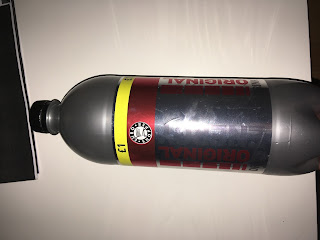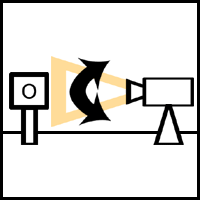Different camera angles and shots will be chosen to emphasise various elements on the screen. For example, if an airplane flying overhead is of importance to the story, filmmakers may choose to use a low-angle shot to show the significance of the plane in the sky. Needless to say, cinematographers will choose different angles for different scenes within the same movie depending of the scene goal or purpose.
Here are some of the shots I researched:
Low angle
This is a shot of an object of person from below looking up and it is sometimes referred to as a "worm shot". It is used to increase the height of an object to make it seem more powerful or threatening, likewise to apply dominance to a person in a scene. Typically, the background is the sky or a ceiling which creates a sense of disorientation within the viewer through the lack of setting.
 Canted angle
Canted angle
In this shot the camera is set on an angle on its roll ax so that the shot is composed of vertical lines at an angle to the side of the frame. This viewpoint makes you tilt your head to the side and is often used to portray psychological uneasiness or tension in the subject being. A handheld camera is normally used for this effect.
High angle
A high angle shot is looking down upon a subject or an object. This shot is used to make the subject seem vulnerable or "chicken" when applied with the correct mood, setting and effects. It can be used to make people seem less significant and the audience more dominant simultaneously.
 Eye level
Eye level
This is a rather neutral and generic shot in terms of camera angles and this is most common within film. Typically the camera is positioned as if the audience is observing a scene among the characters present on screen. This shows a levelled focus with someone else's head and the camera is placed about six feet from ground level.
Bird's-Eye View

This angle is similar to what a bird would see whilst flying above. Sometimes this is used as an establishing shot to show where the character is or where it is that they are travelling to. To use this in a film footage, it is typically shot from a helicopter.
Extreme long shot

This is taken very far away from the focus of the shot and this distance is usually about a quarter of a mile. Often this is used for the beginning of a film or to set the scene when characters arrive in a new setting. There is not a lot of detail in shot, just enough for the audience to create an impression of the scenario itself. Generally it is just the location or buildings in these shots. An example would be if there was one character on their own in an extreme long shot, it would give the impression to the audience that this character is particularly isolated.
Long shot

In film production, a long shot (sometimes referred to as a full shot or, to remove ambiguity, wide shot) typically shows the entire object or human figure and is usually intended to place it in some relation to its surroundings. These are typically shot using wide angle cameras.
 Establishing shot
Establishing shot
This shot establishes the context of the scene showing where the programme/film is set. Typically it is the first shot of a new scene and producers usually use a long or extreme long shot to do so.
Master shot
This is a shot when all of the actors are kept in view on screen for the duration of the entire scene. Usually this is a long shot to ensure that all of the action can be observed. This can sometimes perform as a double function as an establishing shot.
 Mid-shot
Mid-shot
In a mid shot, the figure is generally viewed from the knees or waist up. An example of this would be used is when there is little to no dialogue in the scene. The background would have minimal detail as this would have been established earlier on in the scene. This image would be a good example because the scene appears to feature more action than it does dialogue; it is creating tension.
Close-up

This shot tightly frames an object or a person with little background featuring. It is used to highlight the significance of a moment, thing or reaction. Generally everything on screen, besides the face and the mise en scene, is blurred or kept simple to magnify the importance of the action taking place. If there is a character in this shot, it has usually been done so the audience can see their expression and empathise with their emotion.
Extreme close-up
This shot is even more zoomed in than the close-up and it is done for further emphasis and effect. More often than not, it magnifies beyond what the human eye can see and experience in reality. Generally it is used on an area of the face, such as the eyes, and there is no background so that all focus is on one feature. It is used to show deeper emotion within a character for further sympathy, and it gives a dramatic effect. This shot can also be used on objects e.g. a ring to show the significance of that particular symbol.
Shot reverse shot

This is a continuity editing technique used in conversations or simply characters looking to one another or at an object. It shows what the character is looking at followed by a reverse angle shot of the character themselves looking at it, or of the other character in the scene. This often ties in with the 180° rule to retain continuity and not distort the audience's sense of location of the characters in the shot.
Over the shoulder

This is a shot of someone or something taken from the perspective of over the shoulder of another person. To emphasise this, the back of the head and shoulder of the person is usually kept in shot and used to frame the image. It is a common shot if two people are having a discussion and it can often follow an establishing shot so the audience can place the characters.
Two shot
This shot includes two people, although these people do not have to be next to each other. It is useful to display the emotional reactions between the subject and because they have more focus on them, it gives the characters more importance. When the characters are not in the same frame, the two shot is when there are two people caught within the same camera movement.
Point of View (POV)

This is a shot from a first person or subjective camera that shows the audience exactly what the character is looking at, represented through the camera. It is usually established by being positioned between a shot of a character looking at something, and a shot showing the character's reaction. The technique of POV is one of the foundations of film editing.
Using the research I have done and by analysing what looks best for particular scenes in a short film, I think the exploration of these camera techniques has benefitted me; I can now ensure that in my short film I make each shot fulfill its potential and make sure that all camera movements have a reason behind them. This will encourage me to think much more carefully about each shot I take and hopefully mean I am more successful in keeping my target audience engaged throughout.





























